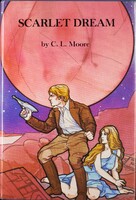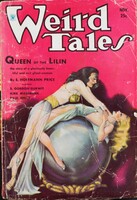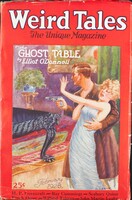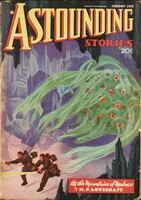-
Clark Ashton Smith was an American author of science fiction in the planetary romance subgenre. He published frequently in Weird Tales.
-
Robert Hayward Barlow was an author and anthropologist. He lived in Mexico for part of his adult life. Barlow was a friend and collaborator of Lovecraft, and his literary executor. He wrote his own short fiction and poems and contributed to the Cthulu mythos. (Wikipedia - Robert H. Barlow)
-
Howard Phillips Lovecraft was an American author of weird, fantasy, and science fiction. He was most often published in Weird Tales, and famously developed the Cthulu mythos. While he was not well-known during his lifetime, his legacy in supernatural horror has been immense. Lovecraft's stories are about the decline of civilization and cosmicism; he held racist views and his stories have been criticized on that basis.
-
Richard Burton Matheson was an America writer of short fiction, novels, and scripts in the science fiction and terror genres. Some of his novels have been adapted for the screen, including I Am Legend and The Incredible Shrinking Man, and his work for television includes 14 scripts for The Twilight Zone and several episodes of Star Trek. The dominant theme of his work is paranoia.
-
John Ronald Reuel Tolkien was a British author of high fantasy, greatly influenced by his academic career as a medievalist. The Hobbit and The Lord of the Rings series drove a resurgence in the fantasy genre in the twentieth century, and have been adapted into two enormously successful film series.
He wrote other works set in Middle-Earth, some of which have been published posthumously by his son, Christopher.
-
Philip Kindred Dick was an enormously influential American author of science fiction stories and novels. His work often dealt with complex issues of reality and alternate history, authoritarian government, and metaphysics. The Encyclopedia of Science Fiction says of his writing: "Even te most perilous metaphysical terrors of his finest novels wore a complaining, vulnerable, human face. In all his work he was astonishingly intimate, self-exposed, and very dangerous. He was the funniest SF writer of his time, and perhaps the most terrifying."
Dick's novel Do Androids Dream of Electric Sheep was adapted into the very successful sci-fi film, Blade Runner, and his works have inspired many other films and television projects.
-
Harlan Ellison was a science fiction author with a reputation as a controversial figure due to his temperament and combativeness, his litigiousness, and his support of Ed Kramer, a convicted pedophile; nevertheless he is acknowledged as a brilliant an influential author of the genre. He has published over 1700 works (Wikipedia - Harlan Ellison) including short stories, novels, television scripts, screenplays, and criticism. He has won many Hugo and Nebula awards, and many other accolades.
Some of his best known works are the script for the Star Trek episode The City on the Edge of Forever, the short story "I Have No Mouth, and I Must Scream," and his A Boy and His Dog story cycle.
-
Poul Anderson was an American author of science fiction and fantasy with a degree in Physics, influenced by time living in Denmark and his Scandinavian parents. He published extensively in pulp serials and wrote many novels. Anderson's work was sometimes regarded as conservative in its values.
Anderson won seven Hugos and three Nebula awards for his work, among other honours (Wikipedia - Poul Anderson).
-
Octavia Estelle Butler was an influential American author of science fiction. Her work foregrounds issues of class, race, and gender; her importance as a prominent Black author in a genre traditionally dominated by white authors is immense. Her novel Kindred has been adapted into a graphic novel and several of her novels are currently being developed for television series. Butler won multiple Hugo and Nebula awards, and she was the first science fiction writer to receive a MacArthur Fellowship (Wikipedia - Octavia Butler).
-
Ursula Kroeber Le Guin was an author of speculative fiction, including the Hainish series, and fantasy, notably the Earthsea series. She often explores themes of alternative social structures in her science fiction. Le Guin has had enormous success even in the mainstream; in 2016 the New York Times called her the "greatest living science fiction writer" (Wikipedia - Ursula K. Le Guin). She has won numerous awards for her work, including Hugo, Nebula, and Locus awards.
-
William Gibson is a American-born Canadian author of science fiction, particularly cyberpunk. He writes near-future urban noir novels in which technology becomes part of consumer culture of late capitalism. He has coined many terms relating to cyberculture and the internet, and has had enormous influence over science fiction novels and films (Wikipedia - William Gibson). Gibson has won Hugo, Nebula, and Philip K. Dick awards, among others.
-
Linwood Vrooman Carter, aka Lin Carter. was an editor, American author of heroic fantasy and science fiction, and fantasy scholar. He produced many novels and has been criticized as more concerned with quantity than quality.
-
Robert E. Howard was a short-lived but influential writer of fantasy; he was the father of the sword and sorcery subgenre. He wrote for pulps and added a few stories to the Cthulu mythos. His most famous works centre on his original character Conan ( famously adapted in film as Conan the Barbarian by Arnold Schwarzenegger).
-
Raymond King Cummings wrote over 750 stories and was a quintessential pulp author. His work was sometimes mechanical and he wrote primarily space romances and adventures when working in the sci-fi genre.
-

Alicia Austin is a science fiction and fantasy illustrator who has illustrated works by Poul Anderson, C.L. Moore, Andre Norton, and Ursula K. Le Guin, among others. (Wikipedia - Alicia Austin)
-
Charles Schneeman was a cover and interior artist for pulp magazines.
-
Hans Waldemar Wessolowski, aka H.W. Wesso, was a popular German-born artist for pulp magazines. He used black and white drawings and watercolours in work for titles like Astounding Stories of Science Fiction and Thrilling Wonder Stories.
-

Margaret Brundage was a pulp cover artist best known for her erotic pastel covers for Weird Tales, which featured nudity and often damsels-in-distress.
-

Curtis Charles Senf was a pulp cover artist born in Russia. He drew 45 covers for Weird Tales (source: https://www.pulpartists.com/Senf.html)
-
Miriam Allen deFord was a newspaper reporter and author of mystery and science fiction stories. She came to writing sci-fi later in her life but published over thirty stories.
-
Gertrude Barrows Bennett, aka Francis Stevens, was an American author of fantasy and science fiction. She pioneered a dark fantasy style and wrote to high acclaim. Her work was published in pulp magazines and as novels.
-
Frederick Orlin Tremaine was an editor and writer of science fiction. He published short fiction himself and edited fifty issues of Astounding Stories/Astounding Science Fiction, leading it through a period as a pre-eminent magazine of its day; he chose John W. Campbell, Jr. as his successor.
-
Clifford Donald Simak was a newspaperman and writer of science fiction who was part of John W. Campbell Jr.'s writers in the Golden Age of SF; he continued to publish short fiction and novels into the 1970s. His works were often set in Wisconsin, and were nostalgic and emotional, in praise of rural values without much violence. He is the winner of an International Fantasy Award and a Hugo Award, among other accolades.
-
August William Derleth was an American science fiction writer and editor. He is well-known as a devoted fan of Lovecraft, and co-founded Arkham House Press to publish Lovecratf's stories. He edited anthologies of sci-fi and weird fiction. He also wrote his own stories for pulps like Weird Tales and Strange Stories, as well as many novels in the detective genre.
-

Howard Vachel Brown was an artist who drew covers for Scientific American, Thrilling Wonder Stories, and Astounding Science Fiction, among others. He was one of the "Big Four" science fiction illustrators of the 1930s. His style is dramatic and uses a softened colour palette.



